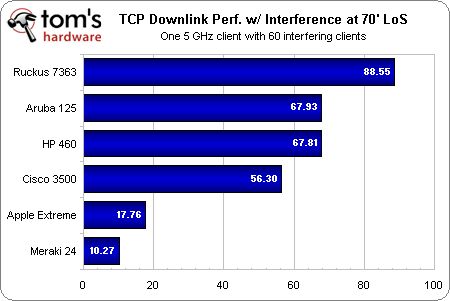Why Your Wi-Fi Sucks And How It Can Be Helped, Part 2
In Part 1, we explained what can go wrong with Wi-Fi signals and how access points can work to improve your wireless performance. It's time for a reality check. We throw six contenders against 65 clients and some hellish interference. Who's left standing?
Benchmark Results: Mid-Range, 1 Versus 60 Clients
Now we get to the fun stuff. If there was ever a question whether nearby devices could cause interference with your own Wi-Fi connection, these tests should prove the answer. Compare the 102 to 136 Mb/s seen on the prior page’s no-interference downlink tests with these numbers. HP, Cisco, and Aruba hold up fairly well, only giving up 30 or 40 Mb/s. Meraki and Apple are simply crushed.
Uplink performance in the face of 61 interfering devices tells the same story, only worse. Apple manages to limp along and complete the test. Meraki simply rolls over and gives up part-way through the test run.
In these circumstances, Ruckus’ adaptability can come into full play. Beamforming, spatial multiplexing, polarization diversity, and all the rest assist with the downlink. If nothing else, the ability to ignore interference through the use of directional antennas (see part 1, page 16) clearly benefits Ruckus’ uplink performance.
Again, pinpointing exact reasons why this or that access point falls on its face would be largely speculative. We could mention that Apple and Meraki are the two least-expensive APs in our group, and maybe the “you get what you pay for” principle is dominating these results. After all, whatever the marketing bullet points say, you don’t get a luxury sedan for the price of an econobox.
Moreover, you might be starting to see a pattern here with Cisco. Like Ruckus, Cisco suffers at short range, but at longer distances, Cisco performs well, even against a storm of interference. Clearly, Cisco put a lot of attention into refining its receive sensitivity, which would explain the 3502i’s second-place showing in our uplink test here.
Get Tom's Hardware's best news and in-depth reviews, straight to your inbox.
Current page: Benchmark Results: Mid-Range, 1 Versus 60 Clients
Prev Page Benchmark Results: Mid-Range, No Interference Next Page Long-Range, No Interference-
winner4455 Hey, I still haven't read this article but right away I notice the new format. Just thanking you for listening to your readers! :)Reply -
cangelini Very welcome Winner. We thought the picture story format would work for that last part and didn't realize the text would come out to be so terrible. From now on, we'll only use picture stories when the captions fit without requiring another click!Reply -
tacoslave cangeliniVery welcome Winner. We thought the picture story format would work for that last part and didn't realize the text would come out to be so terrible. From now on, we'll only use picture stories when the captions fit without requiring another click!"Now thats what i like to hear!"Reply -
nekromobo What if you add few thin-foil balls to room (the size of fist or 2)Reply
That should add few rf-reflections or paths, right?
Just your 2cent amplifier.. :) -
I wonder why you didn't include Juniper products (formerly trapeze)to this test. It's quit a big player here in europe. Trapeze also produced the 3com wireless manager and accesspoints which was sold widely here.Reply
-
Hupiscratch In the page "Benchmark Results: Close Range, No Interference", the HP AP is missing on the downlink graph.Reply -
Onus This was an outstanding article. Going just by this, Ruckus and Cisco are the only two I'd consider out of the box, but it would be very interesting to do a follow on that features even a minimal amount of tweaking to see what changes. A consumer expects a product to work well out of the box, but an enterprise network engineer almost certainly does not.Reply
-
Very thorough. Lots of hard work went into this and it shows. But how did you select client devices? Did you try any other chipsets? We tried something like this with more diverse clients and got results that were too variable to reach conclusions. (Some clients just did better with some APs than others.)Reply

